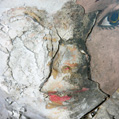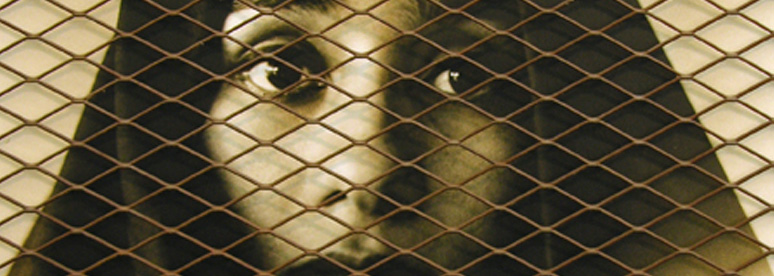PAST EXHIBITION

The Disappeared
An exhibition organized by the North Dakota Museum of Art and curated by Founding Director Laurel Reuter
November 19, 2008 – January 25, 2009
ABOUT THE EXHIBIT
“To disappear” was newly defined during periods of military dictatorship in Latin America. “Disappear” evolved into a transitive verb describing individuals considered threats to the State who were kidnapped, tortured, and killed by their own military.
The Disappeared gathers the work of thirteen visual artists plus a collaborative work by thirteen others from Latin America who over the last 30 years have made art about the disappeared and addressed universal human rights concerns in a powerful and moving way. It contains works by some of the most prominent artists from Argentina, Brazil, Chile, Colombia, Guatemala, Uruguay, and Venezuela. Many of them lived through the horrors of the military dictatorships that rocked their countries in the mid-decades of the twentieth century. Some worked in the resistance; some had parents or siblings who were disappeared; others were forced into exile. The youngest were born into the aftermath of those dictatorships. And still others have lived in countries maimed by endless civil, drug, and guerrilla wars.
The Disappeared is a traveling exhibition organized by the North Dakota Museum of Art and curated by Founding Director Laurel Reuter. The exhibition catalog, authored by Reuter with a preface by Lawrence Weschler, was published by Charta of Milan and New York and is distributed by D.A.P. in the United States and Europe. According to New York Times critic Holland Cotter, “the bilingual catalog is a work of art in itself. From Ms. Reuter’s stunning essay to the supplementary material, it is a total-immersion emotional experience.” (April 7, 2007)
Prior to coming to the Art Museum of the Americas, The Disappeared was shown at the Museo del Barrio (New York), the Centro Cultural Recoleta (Buenos Aires), the Museo Nacional de Artes Visuales (Montevideo), Site Santa Fe (Santa Fe, New Mexico), Centro Cultural Matucana 100 (Santiago de Chile), Centro de Formación de la Cooperación Española (Antigua, Guatemala), and the Museo de Arte Moderno (Bogotá, Colombia). The artists in The Disappeared use their work to address grave concern over forced disappearances. Many reference their own personal experiences as well as those of their families and their countries as a whole through their respective artistic mediums.
Luis Camnitzer left Montevideo, Uruguay, in the early 1960s. Two decades later he watched from afar as the companions of his youth were kidnapped, tortured, and disappeared. In protest and as a sign of solidarity he completed the thirty-five etchings that comprise From the Uruguayan Torture Series.
Marcelo Brodsky returned to his homeland of Argentina after years in Spain, and began to search for his friends from the past. His research resulted in Good Memory, a photograph of his high school class onto which he scrawls updates on what became of many of his classmates. Also in the exhibit is Brodsky’s photograph of the Plata River, a place where Argentinians and Uruguayans alike have all too often found permanent resting place during periods of military dictatorships. The artist’s disappeared brother Nando was the inspiration for this piece. Colombian Juan Manuel Echavarría gave up his life as a novelist to become a photographer. His NN (no name) installation examines the destruction that inevitably accompanies violence against both the individual and the society as a whole. His complex work overlays the notion of decay with a horrific beauty.
Chilean artist Iván Navarro exhibits a thirty-foot ladder whose lighted rungs list the names of 600 people recently indicted for the killing of their own fellow countrymen. The flipside of Navarro’s piece is Arturo Duclos’s flag that intertwines the bones of the victims with their killers. Similarly, Argentinian Fernando Traverso painted 350 bicycles throughout his home city of Rosario, the symbolism being that often the first sign that someone has disappeared is that their abandoned bicycle is found.
By hosting this human-rights themed exhibition, the Art Museum of the Americas places itself in high-sync with the mandates of its parent organization, the OAS, which has constantly worked against violations of personal freedoms across the Western Hemisphere. With origins dating back to the adoption of the American Declaration of the Rights and Duties of Man in Bogotá, Colombia, in 1948, the Inter-American Commission on Human Rights (IACHR) has held close to 100 sessions both at the OAS headquarters in Washington and abroad. In 1994, the OAS General Assembly adopted the Inter-American Convention on Forced Disappearance of Persons, an agreement between OAS member countries that the forced disappearances of persons cannot be practiced, permitted or tolerated, and that member countries will cooperate with one another in order to hold responsible accountable parties.
The IACHR continues to observe general human rights situations, carrying out on-site visits to countries to investigate and analyze individual petitions case by case, recommending measures to contribute to the protection of rights, and ultimately submitting cases to the Inter-American Court for litigation.
FEATURED ARTISTS
Marcelo Brodsky (Argentina)
Luis Camnitzer (Uruguay, lives in New York)
Arturo Duclos (Chile)
Juan Manuel Echavarría (Colombia)
Antonio Frasconi (Uruguay, lives in New York)
Nicolas Guagnini (Argentina, lives in New York)
Sara Maneiro (Venezuela)
Cildo Meireles (Brazil)
Oscar Muñoz (Colombia
Iván Navarro (Chile, lives in New York)
Luis Gonzáles Palma (Guatemala, lives in Argentina)
Ana Tiscornia (Uruguay, lives in New York)
Fernando Traverso (Argentina)
The exhibition also includes a collaborative work be Argentinean artists Carlos Alonso, Nora Aslán, Mireya Baglietto, Remo Bianchedi, Diana Dowek, León Ferrari, Rosana Fuertes, Carlos Gorriarena, Adolfo Nigro, Luis Felipe Noé, Daniel Ontiveros, Juan Carlos Romero, and Marcia Schvartz.

